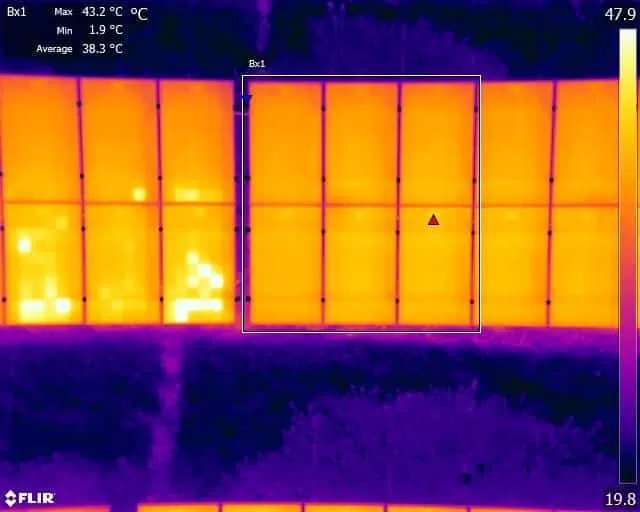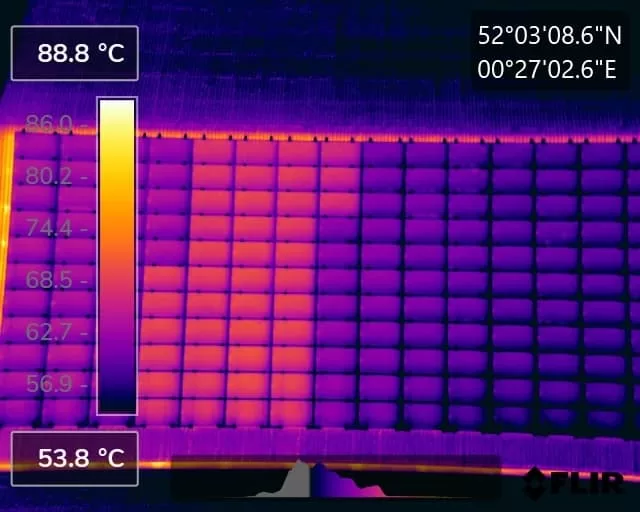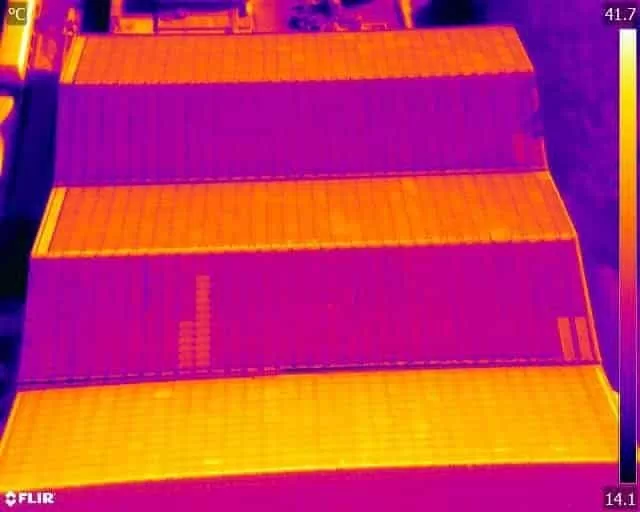
Photovoltaic Solar Panel Inspections
Of course, the vast majority of solar panels are installed on sloping roofs which can make manual surveys by people difficult. Invasive scaffolding or a cherry picker may be required and there is always a risk of damage to the roof itself during the inspection process.
So, it’s not surprising that many people are put off by the cost and inconvenience of domestic solar panel inspections if there are no visible faults or issues evident from the ground.
However, thermal infrared inspections using a commercial Unmanned Aerial Vehicle (UAV or Drone) can complete a detailed PV panel inspection quickly, simply, and cheaply with the need for further maintenance only then being required if a fault issue is found. One simple inspection, every couple of years under the right solar irradiation conditions can be all that it takes to make sure that your solar panels stay safe and efficient. With many panels being covered by a long term warranty, there is a good chance that any fault repairs required will be at no additional cost to the home owner as well!


All of these issues can be visualised without ever touching the panels or roof structure – making it the perfect routine inspection tool.
Drone Thermography of your solar panel can detect
Optional String Electrical Testing
In addition to thermal imaging, we offer optional string-level electrical testing using compliant industrial grade equipment and protocols.

- Open-circuit voltage (Voc),
- Short-circuit current (Isc),
- I-V curve tracing,
- Polarity
- IR – insulation resistance checks
Helping to identify electrical faults not visible thermally.
This is a non-invasive service performed from ground level at the inverter/string combiner. No access to the roof or inverter internals is required. We operate strictly within the Survey → Analysis → Reporting framework, providing compliant data for your installer or contractors to act upon if repairs are needed.
Geotagged thermal images: Every thermal image is GPS-tagged and timestamped, allowing you or your installer to quickly locate and verify the exact position of any anomalies identified during the inspection.
Anomaly descriptions: We classify and describe all visible thermal faults — such as hotspots, shading, bypass diode issues, or soiling — with clear annotations and professional terminology aligned to IEC 62446-3.
Optional electrical test results (when selected): If electrical testing is selected, we include string-level results such as voltage, current, insulation resistance, polarity, and I-V curve shape, helping confirm electrical health or highlight performance concerns.
Prioritised recommendations: Issues are graded by severity and urgency, allowing your maintenance provider to focus first on the most critical faults likely to impact system performance or safety.
Full PDF report for your installer or O&M provider: All findings are compiled into a clear, structured report formatted to industry standards, enabling your installer, electrician, or solar contractor to take appropriate action based on verified data.
A UAV/Drone can be a fast and efficient diagnostic tool to pinpoint faults when electricity production has dipped. to be able to give to your panel maintenance provider.

Drone Media Imaging can deploy a thermal imaging camera via drone at very competitive rates, wherever you are in the UK. We can operate at reduced distances to other properties and people under our OSC (Operating Safety Case) which are unique enhanced operating permissions granted to us by the CAA. We are also qualified as category 2 thermographers which means that we understand the correct thermal conditions necessary to create meaningful and accurate data, along with the correct interpretation, and can provide you with a detailed inspection report which will show you where the faults are.
Just get in touch to discuss your requirements. Get in Touch
Drone Media Imaging now offers certified IEC 62446-compliant solar string testing, delivering complete electrical diagnostics for commercial PV systems. This new service verifies string integrity, insulation, voltage, current, and performance using advanced I-V curve tracing and Fill Factor analysis. Ideal for commissioning, troubleshooting, and maintenance, our testing supports safety, compliance, and ROI assurance. Combined with thermal imaging, we offer a powerful dual-inspection approach. Book today to ensure your solar array is operating safely, efficiently, and within international performance standards.
We supported a large thermal inspection project across three residential buildings by providing certified Level 3 thermographic reporting based on drone data collected by the client. Using a protocol we developed, they captured radiometric thermal images, which we analysed remotely to identify heat loss, glazing issues, and roof moisture indicators. This collaborative approach showcases how our clients can carry out surveys independently, while we deliver professional-grade thermographic interpretation and reporting — cost-effectively and without needing site access.
10m Take off & 20m Flight
Legally, drones are required to remain a 50m distance from People, Property, Vessels, and Vehicles that are not under the control of the pilot. We, however, have enhanced permissions from the CAA that means we can get as close as 10m, reducing the need to contact and liaise with your neighbours or closing roads to fly near them.
FLIGHT TIMES ARE SHORT AND SIMPLE
Solar panels are usually fitted on one side of your house roof, looking south to ensure that the maximum solar radiation is captured efficiently. This means that the flight need is very small and simple, it is just a case of flying up above the panels to the correct angle of incidence to collect the thermal images required. Our time at your property is very short.
WEATHER REQ FOR SOLAR INSPECTIONS
Solar panels need to be operating at full load for thermal inspection to take place and all errors/faults to be clearly seen, this is equivalent to 600 watts/m2 to meet BSI standards. (400 watts/m2 can be ok for some main issues). This means that we conduct solar panel inspection in the summer months ideally usually between May and September.




